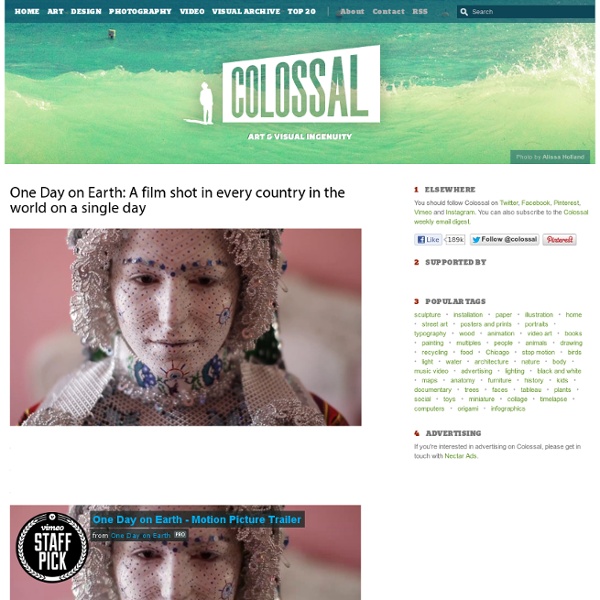Selfie deaths: 259 people reported dead seeking the perfect picture
Image copyright Getty Images The quest for extreme selfies killed 259 people between 2011 and 2017, a 2018 global study has revealed. Researchers at the US National Library of Medicine recommend that 'no selfie zones' should be introduced at dangerous spots to reduce deaths. These would include the tops of mountains, tall buildings and lakes, where many of the deaths occurred. Drowning, transport accidents and falling were found to be the most common cause of death.
Ode to Empathy
The discussion around empathy seems to be growing exponentially. From the huge splash Brené Brown is making with her work on shame, vulnerability and empathy to Jeremy Rifkin’s vision of our moving towards an Empathic Civilization, empathy is becoming a 21st century buzzword. And rightfully so. With the emergence of a global civilization, we need to move beyond the “us and them” mentality that lends itself to so much conflict, violence, and self-destruction.
The Girl Who Loves to Levitate (14 photos)
Natsumi Hayashi is a sweet-looking Japanese girl who, one day, decided to take self-portraits..of herself levitating. She can be spotted in and around Tokyo, equipped with her SLR and her self-timer. When she feels the moment strike, she presses the shutter button down and then, quite literally, "jumps" into place. What I love most about her shots is that they don't feel forced. Natsumi has a way of making us feel as though she naturally levitates throughout life.
Akiyoshi's illusion pages
Akiyoshi's illusion pages Akiyoshi KITAOKA, Professor, Psychology, Ritsumeikan University, Osaka, Japan studying visual perception, visual illusion, optical illusion, trompe l'oeil, 3D, etc. Since May 18, 2002; Updated June 30, 2020 Japanese, Serb, Portuguese, Chinese; Illusion calender 2019
Trust
Explanations > Trust Trust is | Creating trust | When trust goes wrong | So what? Trust is the key to the door of other people's minds.
Hypnagogia and Hypnopompia
Hypnagogia is the imagery, sounds and strange bodily feelings that are felt at “sleep onset.” This is a simplification though, as researchers have noted hypnagogic imagery in the lab at periods of quiet wakefulness as well as stage 1 sleep. Others have correlated hypnagogia with pre-sleep alpha waves and also REM intrusion into sleep onset. The truth is that the wake-sleep transition is still not understood. And neither are its trippy visuals. whispy lights, multi-dimentional geometric objects, or a sudden image like a stranger’s face
Using Open Source Design to Address Climate Change
A growing movement that combines open source design with sustainability is creating an exciting alternative to profit-driven, proprietary sustainability products. As we face urgent issues like climate change, the ability of open source communities to quickly and inexpensively create solutions makes increasing sense. One project that clearly recognizes this big opportunity for impact is POC21, an international innovation network whose participants create open-source, sustainability-related products like the 30$ Wind Turbine, Aker (open source urban gardening infrastructure), and Faircap (open source portable water filter). Co-organized by Ouishare co-founder Benjamin Tincq, POC21 has brought together hundreds of designers, makers and organizers to “prototype the fossil free, zero waste society.” An open approach to design and production will allow for the biggest teams possible to create solutions in as little time as possible.
50 Life Secrets and Tips
Memorize something everyday.Not only will this leave your brain sharp and your memory functioning, you will also have a huge library of quotes to bust out at any moment. Poetry, sayings and philosophies are your best options.Constantly try to reduce your attachment to possessions.Those who are heavy-set with material desires will have a lot of trouble when their things are taken away from them or lost. Possessions do end up owning you, not the other way around. Become a person of minimal needs and you will be much more content.Develop an endless curiosity about this world.Become an explorer and view the world as your jungle. Stop and observe all of the little things as completely unique events. Try new things.
The human brain can create structures in up to 11 dimensions
Neuroscientists have used a classic branch of maths in a totally new way to peer into the structure of our brains. What they've discovered is that the brain is full of multi-dimensional geometrical structures operating in as many as 11 dimensions. We're used to thinking of the world from a 3-D perspective, so this may sound a bit tricky, but the results of this new study could be the next major step in understanding the fabric of the human brain - the most complex structure we know of.



